Analysis of Management Functions and Organisational Culture
VerifiedAdded on 2023/06/14
|9
|2097
|181
Report
AI Summary
This report provides an overview of key management functions and concepts within a business context. It examines management structures, business functions like marketing and finance, and the interrelation of management functions such as planning, organising, staffing, and controlling. The report also delves into the role of HR and talent management in fostering a positive organisational culture, including recruitment, payroll processing, and employee record maintenance. The analysis highlights how a strong organisational culture, built on defined beliefs, values, and standards, contributes to achieving business objectives through effective teamwork, while a weak culture can lead to conflicts and mismanagement. The report concludes that effective management, applied systematically, is crucial for achieving organisational goals and maintaining a coordinated and efficient operation.
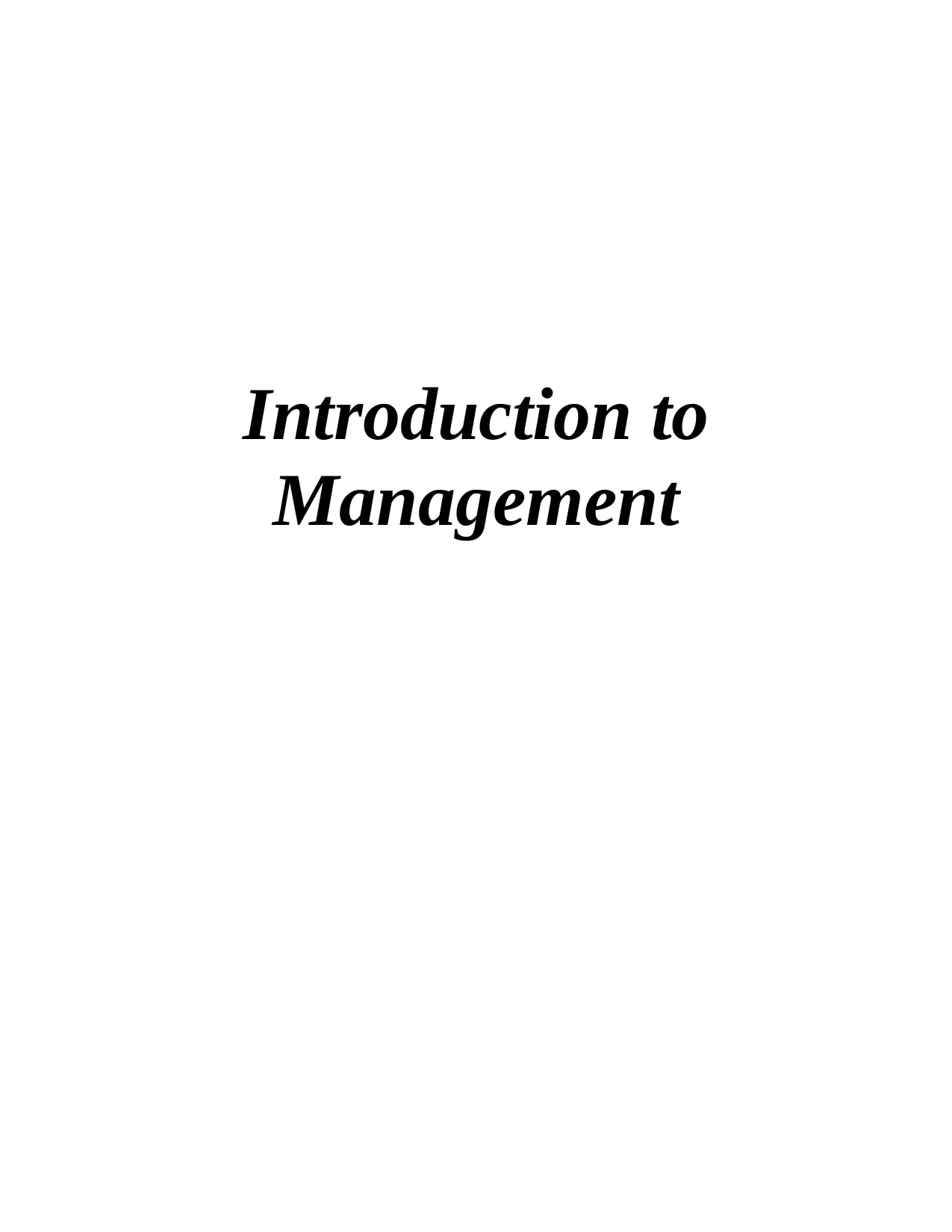
Introduction to
Management
Management
Paraphrase This Document
Need a fresh take? Get an instant paraphrase of this document with our AI Paraphraser
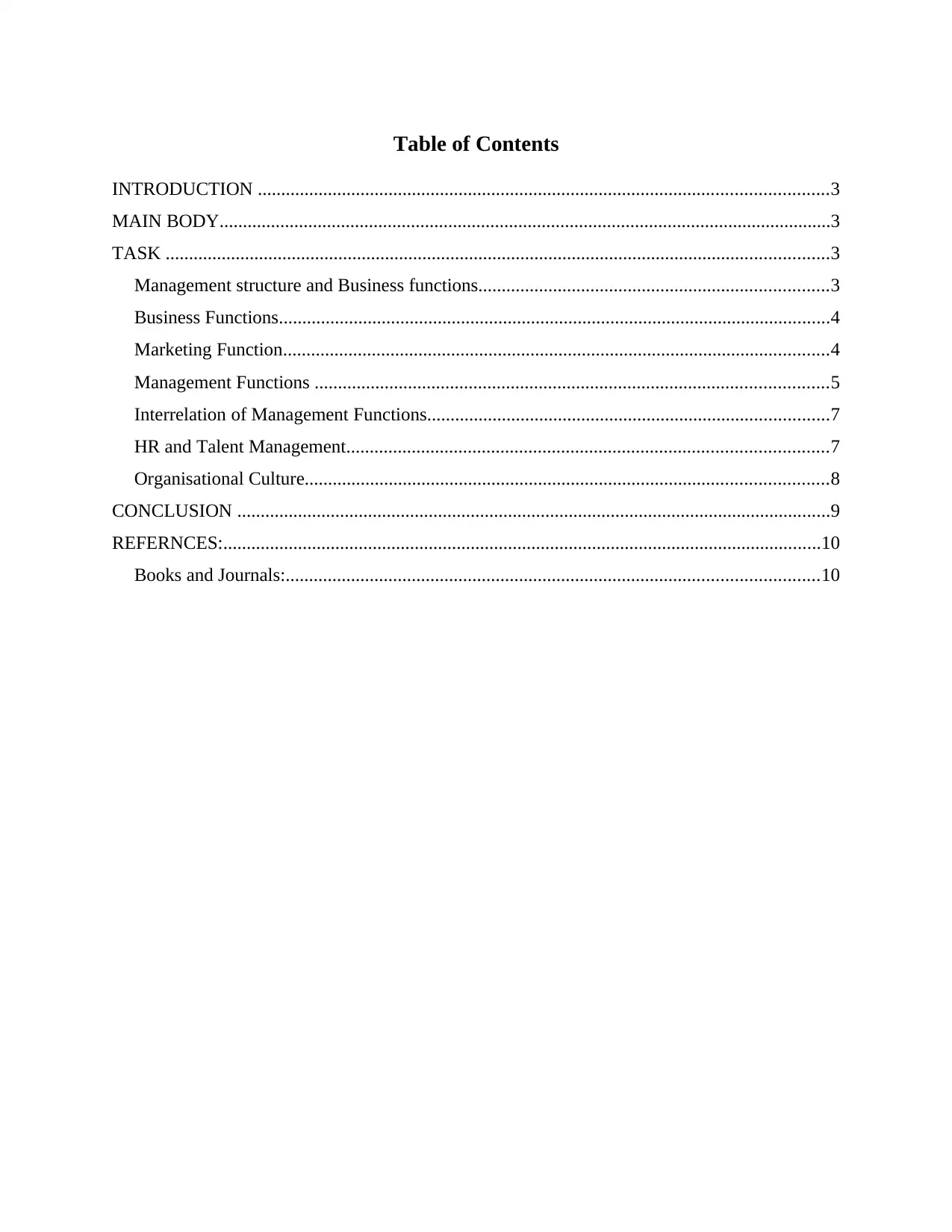
Table of Contents
INTRODUCTION ..........................................................................................................................3
MAIN BODY...................................................................................................................................3
TASK ..............................................................................................................................................3
Management structure and Business functions...........................................................................3
Business Functions......................................................................................................................4
Marketing Function.....................................................................................................................4
Management Functions ..............................................................................................................5
Interrelation of Management Functions......................................................................................7
HR and Talent Management.......................................................................................................7
Organisational Culture................................................................................................................8
CONCLUSION ...............................................................................................................................9
REFERNCES:................................................................................................................................10
Books and Journals:..................................................................................................................10
INTRODUCTION ..........................................................................................................................3
MAIN BODY...................................................................................................................................3
TASK ..............................................................................................................................................3
Management structure and Business functions...........................................................................3
Business Functions......................................................................................................................4
Marketing Function.....................................................................................................................4
Management Functions ..............................................................................................................5
Interrelation of Management Functions......................................................................................7
HR and Talent Management.......................................................................................................7
Organisational Culture................................................................................................................8
CONCLUSION ...............................................................................................................................9
REFERNCES:................................................................................................................................10
Books and Journals:..................................................................................................................10
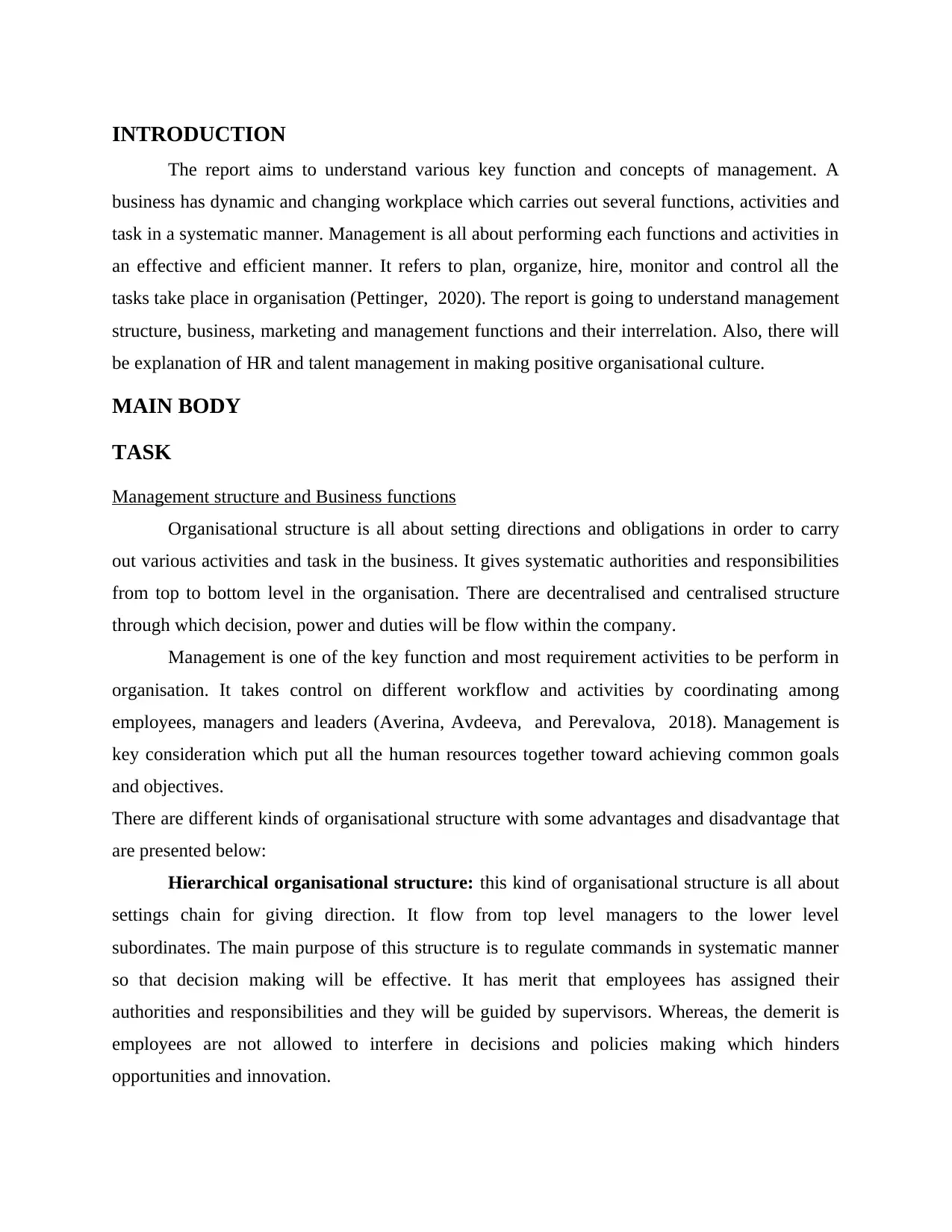
INTRODUCTION
The report aims to understand various key function and concepts of management. A
business has dynamic and changing workplace which carries out several functions, activities and
task in a systematic manner. Management is all about performing each functions and activities in
an effective and efficient manner. It refers to plan, organize, hire, monitor and control all the
tasks take place in organisation (Pettinger, 2020). The report is going to understand management
structure, business, marketing and management functions and their interrelation. Also, there will
be explanation of HR and talent management in making positive organisational culture.
MAIN BODY
TASK
Management structure and Business functions
Organisational structure is all about setting directions and obligations in order to carry
out various activities and task in the business. It gives systematic authorities and responsibilities
from top to bottom level in the organisation. There are decentralised and centralised structure
through which decision, power and duties will be flow within the company.
Management is one of the key function and most requirement activities to be perform in
organisation. It takes control on different workflow and activities by coordinating among
employees, managers and leaders (Averina, Avdeeva, and Perevalova, 2018). Management is
key consideration which put all the human resources together toward achieving common goals
and objectives.
There are different kinds of organisational structure with some advantages and disadvantage that
are presented below:
Hierarchical organisational structure: this kind of organisational structure is all about
settings chain for giving direction. It flow from top level managers to the lower level
subordinates. The main purpose of this structure is to regulate commands in systematic manner
so that decision making will be effective. It has merit that employees has assigned their
authorities and responsibilities and they will be guided by supervisors. Whereas, the demerit is
employees are not allowed to interfere in decisions and policies making which hinders
opportunities and innovation.
The report aims to understand various key function and concepts of management. A
business has dynamic and changing workplace which carries out several functions, activities and
task in a systematic manner. Management is all about performing each functions and activities in
an effective and efficient manner. It refers to plan, organize, hire, monitor and control all the
tasks take place in organisation (Pettinger, 2020). The report is going to understand management
structure, business, marketing and management functions and their interrelation. Also, there will
be explanation of HR and talent management in making positive organisational culture.
MAIN BODY
TASK
Management structure and Business functions
Organisational structure is all about setting directions and obligations in order to carry
out various activities and task in the business. It gives systematic authorities and responsibilities
from top to bottom level in the organisation. There are decentralised and centralised structure
through which decision, power and duties will be flow within the company.
Management is one of the key function and most requirement activities to be perform in
organisation. It takes control on different workflow and activities by coordinating among
employees, managers and leaders (Averina, Avdeeva, and Perevalova, 2018). Management is
key consideration which put all the human resources together toward achieving common goals
and objectives.
There are different kinds of organisational structure with some advantages and disadvantage that
are presented below:
Hierarchical organisational structure: this kind of organisational structure is all about
settings chain for giving direction. It flow from top level managers to the lower level
subordinates. The main purpose of this structure is to regulate commands in systematic manner
so that decision making will be effective. It has merit that employees has assigned their
authorities and responsibilities and they will be guided by supervisors. Whereas, the demerit is
employees are not allowed to interfere in decisions and policies making which hinders
opportunities and innovation.
⊘ This is a preview!⊘
Do you want full access?
Subscribe today to unlock all pages.

Trusted by 1+ million students worldwide
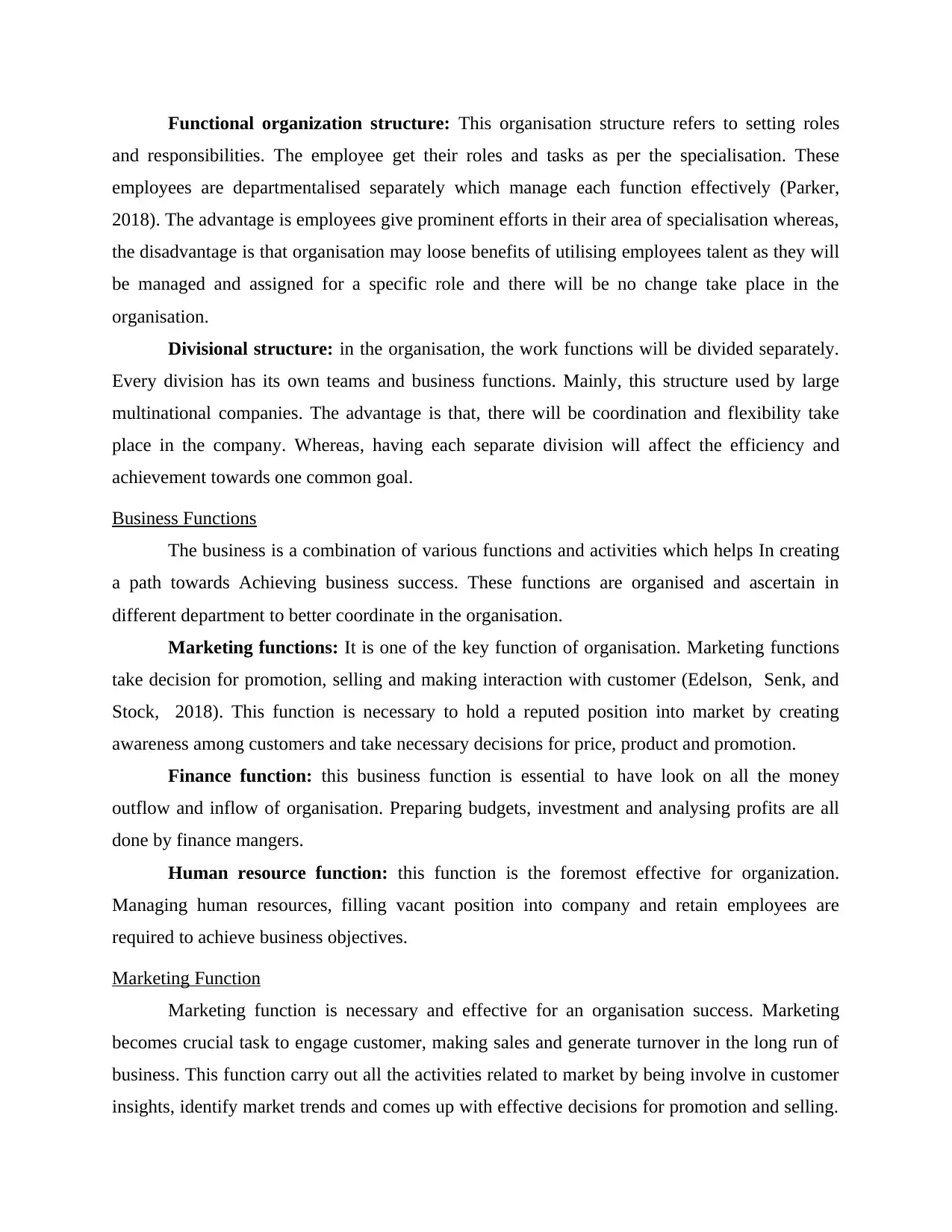
Functional organization structure: This organisation structure refers to setting roles
and responsibilities. The employee get their roles and tasks as per the specialisation. These
employees are departmentalised separately which manage each function effectively (Parker,
2018). The advantage is employees give prominent efforts in their area of specialisation whereas,
the disadvantage is that organisation may loose benefits of utilising employees talent as they will
be managed and assigned for a specific role and there will be no change take place in the
organisation.
Divisional structure: in the organisation, the work functions will be divided separately.
Every division has its own teams and business functions. Mainly, this structure used by large
multinational companies. The advantage is that, there will be coordination and flexibility take
place in the company. Whereas, having each separate division will affect the efficiency and
achievement towards one common goal.
Business Functions
The business is a combination of various functions and activities which helps In creating
a path towards Achieving business success. These functions are organised and ascertain in
different department to better coordinate in the organisation.
Marketing functions: It is one of the key function of organisation. Marketing functions
take decision for promotion, selling and making interaction with customer (Edelson, Senk, and
Stock, 2018). This function is necessary to hold a reputed position into market by creating
awareness among customers and take necessary decisions for price, product and promotion.
Finance function: this business function is essential to have look on all the money
outflow and inflow of organisation. Preparing budgets, investment and analysing profits are all
done by finance mangers.
Human resource function: this function is the foremost effective for organization.
Managing human resources, filling vacant position into company and retain employees are
required to achieve business objectives.
Marketing Function
Marketing function is necessary and effective for an organisation success. Marketing
becomes crucial task to engage customer, making sales and generate turnover in the long run of
business. This function carry out all the activities related to market by being involve in customer
insights, identify market trends and comes up with effective decisions for promotion and selling.
and responsibilities. The employee get their roles and tasks as per the specialisation. These
employees are departmentalised separately which manage each function effectively (Parker,
2018). The advantage is employees give prominent efforts in their area of specialisation whereas,
the disadvantage is that organisation may loose benefits of utilising employees talent as they will
be managed and assigned for a specific role and there will be no change take place in the
organisation.
Divisional structure: in the organisation, the work functions will be divided separately.
Every division has its own teams and business functions. Mainly, this structure used by large
multinational companies. The advantage is that, there will be coordination and flexibility take
place in the company. Whereas, having each separate division will affect the efficiency and
achievement towards one common goal.
Business Functions
The business is a combination of various functions and activities which helps In creating
a path towards Achieving business success. These functions are organised and ascertain in
different department to better coordinate in the organisation.
Marketing functions: It is one of the key function of organisation. Marketing functions
take decision for promotion, selling and making interaction with customer (Edelson, Senk, and
Stock, 2018). This function is necessary to hold a reputed position into market by creating
awareness among customers and take necessary decisions for price, product and promotion.
Finance function: this business function is essential to have look on all the money
outflow and inflow of organisation. Preparing budgets, investment and analysing profits are all
done by finance mangers.
Human resource function: this function is the foremost effective for organization.
Managing human resources, filling vacant position into company and retain employees are
required to achieve business objectives.
Marketing Function
Marketing function is necessary and effective for an organisation success. Marketing
becomes crucial task to engage customer, making sales and generate turnover in the long run of
business. This function carry out all the activities related to market by being involve in customer
insights, identify market trends and comes up with effective decisions for promotion and selling.
Paraphrase This Document
Need a fresh take? Get an instant paraphrase of this document with our AI Paraphraser
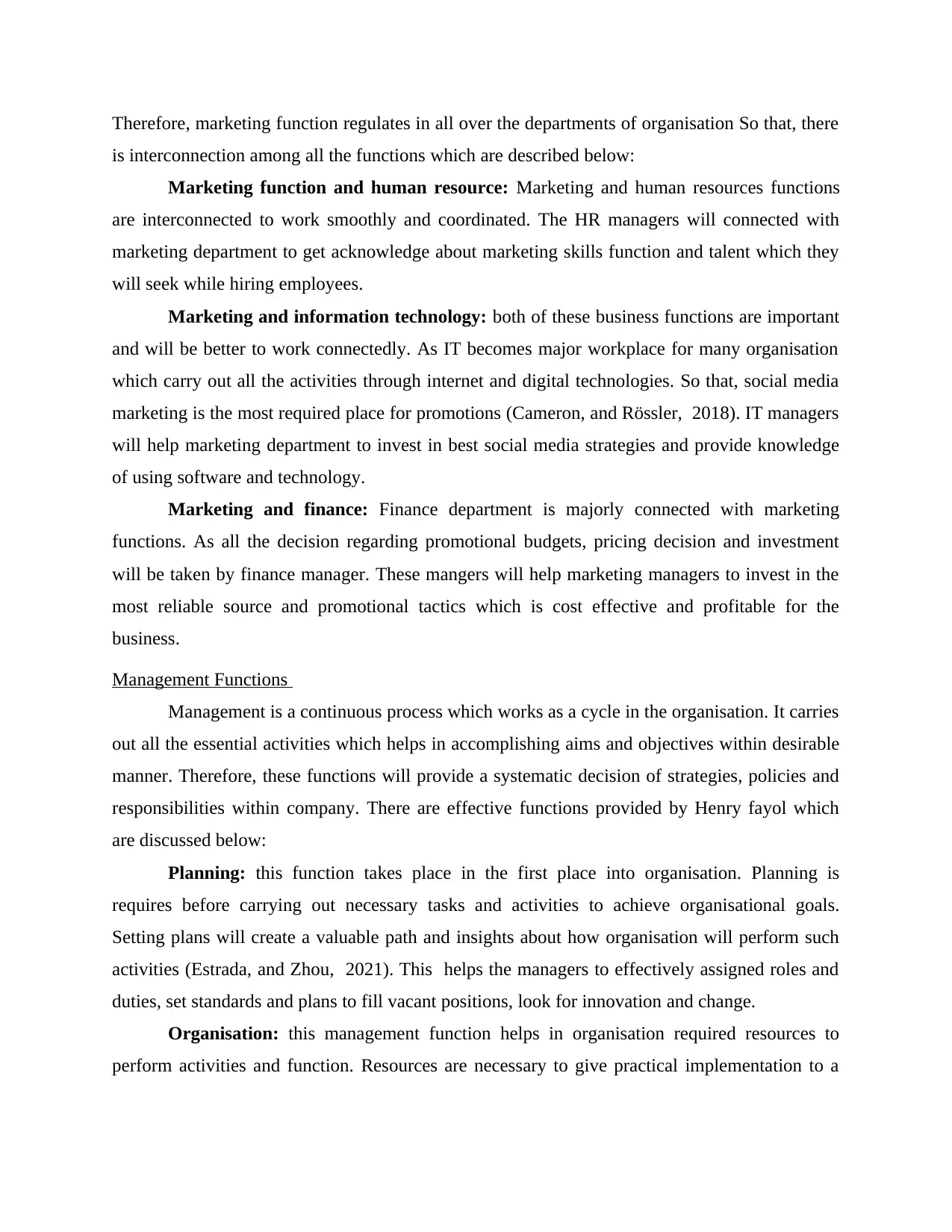
Therefore, marketing function regulates in all over the departments of organisation So that, there
is interconnection among all the functions which are described below:
Marketing function and human resource: Marketing and human resources functions
are interconnected to work smoothly and coordinated. The HR managers will connected with
marketing department to get acknowledge about marketing skills function and talent which they
will seek while hiring employees.
Marketing and information technology: both of these business functions are important
and will be better to work connectedly. As IT becomes major workplace for many organisation
which carry out all the activities through internet and digital technologies. So that, social media
marketing is the most required place for promotions (Cameron, and Rössler, 2018). IT managers
will help marketing department to invest in best social media strategies and provide knowledge
of using software and technology.
Marketing and finance: Finance department is majorly connected with marketing
functions. As all the decision regarding promotional budgets, pricing decision and investment
will be taken by finance manager. These mangers will help marketing managers to invest in the
most reliable source and promotional tactics which is cost effective and profitable for the
business.
Management Functions
Management is a continuous process which works as a cycle in the organisation. It carries
out all the essential activities which helps in accomplishing aims and objectives within desirable
manner. Therefore, these functions will provide a systematic decision of strategies, policies and
responsibilities within company. There are effective functions provided by Henry fayol which
are discussed below:
Planning: this function takes place in the first place into organisation. Planning is
requires before carrying out necessary tasks and activities to achieve organisational goals.
Setting plans will create a valuable path and insights about how organisation will perform such
activities (Estrada, and Zhou, 2021). This helps the managers to effectively assigned roles and
duties, set standards and plans to fill vacant positions, look for innovation and change.
Organisation: this management function helps in organisation required resources to
perform activities and function. Resources are necessary to give practical implementation to a
is interconnection among all the functions which are described below:
Marketing function and human resource: Marketing and human resources functions
are interconnected to work smoothly and coordinated. The HR managers will connected with
marketing department to get acknowledge about marketing skills function and talent which they
will seek while hiring employees.
Marketing and information technology: both of these business functions are important
and will be better to work connectedly. As IT becomes major workplace for many organisation
which carry out all the activities through internet and digital technologies. So that, social media
marketing is the most required place for promotions (Cameron, and Rössler, 2018). IT managers
will help marketing department to invest in best social media strategies and provide knowledge
of using software and technology.
Marketing and finance: Finance department is majorly connected with marketing
functions. As all the decision regarding promotional budgets, pricing decision and investment
will be taken by finance manager. These mangers will help marketing managers to invest in the
most reliable source and promotional tactics which is cost effective and profitable for the
business.
Management Functions
Management is a continuous process which works as a cycle in the organisation. It carries
out all the essential activities which helps in accomplishing aims and objectives within desirable
manner. Therefore, these functions will provide a systematic decision of strategies, policies and
responsibilities within company. There are effective functions provided by Henry fayol which
are discussed below:
Planning: this function takes place in the first place into organisation. Planning is
requires before carrying out necessary tasks and activities to achieve organisational goals.
Setting plans will create a valuable path and insights about how organisation will perform such
activities (Estrada, and Zhou, 2021). This helps the managers to effectively assigned roles and
duties, set standards and plans to fill vacant positions, look for innovation and change.
Organisation: this management function helps in organisation required resources to
perform activities and function. Resources are necessary to give practical implementation to a
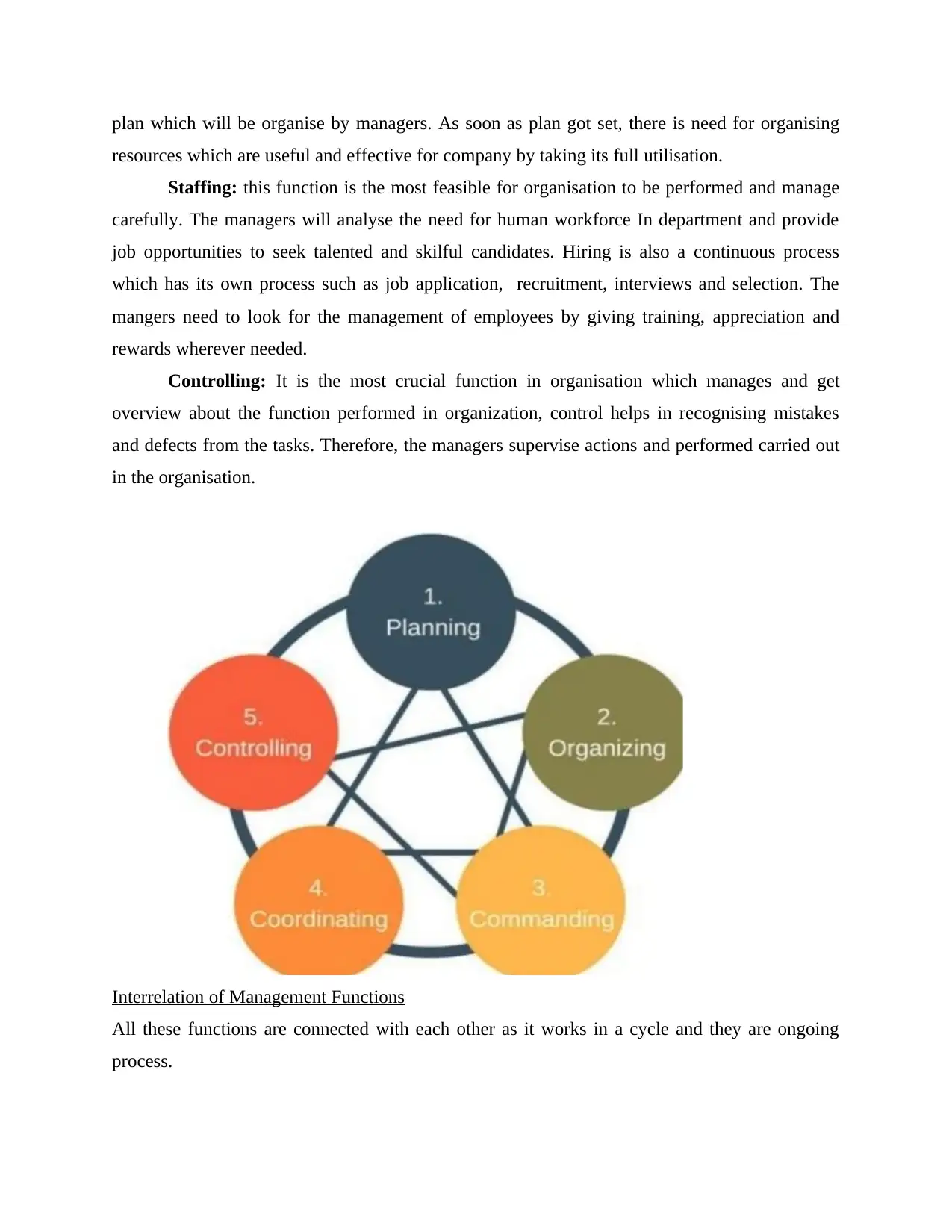
plan which will be organise by managers. As soon as plan got set, there is need for organising
resources which are useful and effective for company by taking its full utilisation.
Staffing: this function is the most feasible for organisation to be performed and manage
carefully. The managers will analyse the need for human workforce In department and provide
job opportunities to seek talented and skilful candidates. Hiring is also a continuous process
which has its own process such as job application, recruitment, interviews and selection. The
mangers need to look for the management of employees by giving training, appreciation and
rewards wherever needed.
Controlling: It is the most crucial function in organisation which manages and get
overview about the function performed in organization, control helps in recognising mistakes
and defects from the tasks. Therefore, the managers supervise actions and performed carried out
in the organisation.
Interrelation of Management Functions
All these functions are connected with each other as it works in a cycle and they are ongoing
process.
resources which are useful and effective for company by taking its full utilisation.
Staffing: this function is the most feasible for organisation to be performed and manage
carefully. The managers will analyse the need for human workforce In department and provide
job opportunities to seek talented and skilful candidates. Hiring is also a continuous process
which has its own process such as job application, recruitment, interviews and selection. The
mangers need to look for the management of employees by giving training, appreciation and
rewards wherever needed.
Controlling: It is the most crucial function in organisation which manages and get
overview about the function performed in organization, control helps in recognising mistakes
and defects from the tasks. Therefore, the managers supervise actions and performed carried out
in the organisation.
Interrelation of Management Functions
All these functions are connected with each other as it works in a cycle and they are ongoing
process.
⊘ This is a preview!⊘
Do you want full access?
Subscribe today to unlock all pages.

Trusted by 1+ million students worldwide
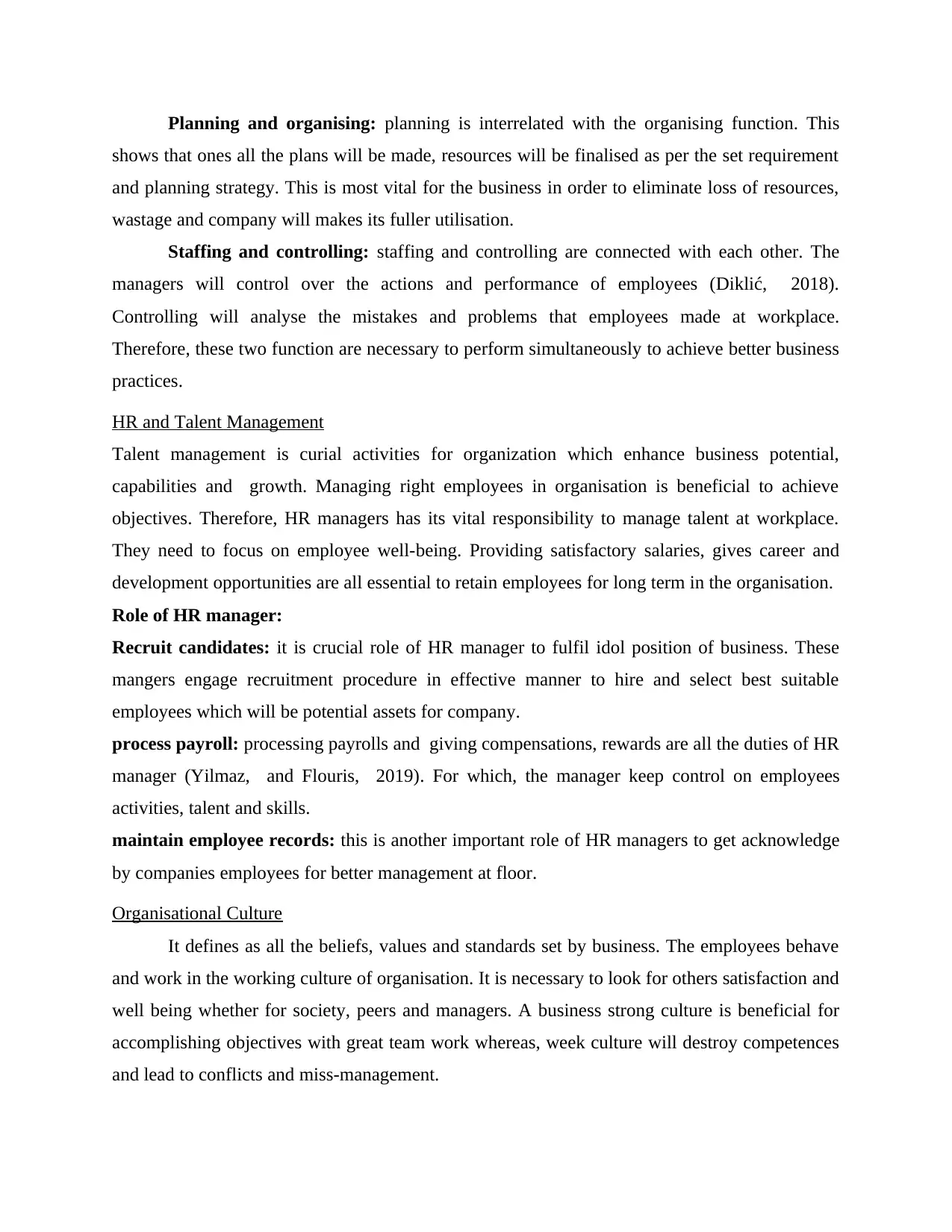
Planning and organising: planning is interrelated with the organising function. This
shows that ones all the plans will be made, resources will be finalised as per the set requirement
and planning strategy. This is most vital for the business in order to eliminate loss of resources,
wastage and company will makes its fuller utilisation.
Staffing and controlling: staffing and controlling are connected with each other. The
managers will control over the actions and performance of employees (Diklić, 2018).
Controlling will analyse the mistakes and problems that employees made at workplace.
Therefore, these two function are necessary to perform simultaneously to achieve better business
practices.
HR and Talent Management
Talent management is curial activities for organization which enhance business potential,
capabilities and growth. Managing right employees in organisation is beneficial to achieve
objectives. Therefore, HR managers has its vital responsibility to manage talent at workplace.
They need to focus on employee well-being. Providing satisfactory salaries, gives career and
development opportunities are all essential to retain employees for long term in the organisation.
Role of HR manager:
Recruit candidates: it is crucial role of HR manager to fulfil idol position of business. These
mangers engage recruitment procedure in effective manner to hire and select best suitable
employees which will be potential assets for company.
process payroll: processing payrolls and giving compensations, rewards are all the duties of HR
manager (Yilmaz, and Flouris, 2019). For which, the manager keep control on employees
activities, talent and skills.
maintain employee records: this is another important role of HR managers to get acknowledge
by companies employees for better management at floor.
Organisational Culture
It defines as all the beliefs, values and standards set by business. The employees behave
and work in the working culture of organisation. It is necessary to look for others satisfaction and
well being whether for society, peers and managers. A business strong culture is beneficial for
accomplishing objectives with great team work whereas, week culture will destroy competences
and lead to conflicts and miss-management.
shows that ones all the plans will be made, resources will be finalised as per the set requirement
and planning strategy. This is most vital for the business in order to eliminate loss of resources,
wastage and company will makes its fuller utilisation.
Staffing and controlling: staffing and controlling are connected with each other. The
managers will control over the actions and performance of employees (Diklić, 2018).
Controlling will analyse the mistakes and problems that employees made at workplace.
Therefore, these two function are necessary to perform simultaneously to achieve better business
practices.
HR and Talent Management
Talent management is curial activities for organization which enhance business potential,
capabilities and growth. Managing right employees in organisation is beneficial to achieve
objectives. Therefore, HR managers has its vital responsibility to manage talent at workplace.
They need to focus on employee well-being. Providing satisfactory salaries, gives career and
development opportunities are all essential to retain employees for long term in the organisation.
Role of HR manager:
Recruit candidates: it is crucial role of HR manager to fulfil idol position of business. These
mangers engage recruitment procedure in effective manner to hire and select best suitable
employees which will be potential assets for company.
process payroll: processing payrolls and giving compensations, rewards are all the duties of HR
manager (Yilmaz, and Flouris, 2019). For which, the manager keep control on employees
activities, talent and skills.
maintain employee records: this is another important role of HR managers to get acknowledge
by companies employees for better management at floor.
Organisational Culture
It defines as all the beliefs, values and standards set by business. The employees behave
and work in the working culture of organisation. It is necessary to look for others satisfaction and
well being whether for society, peers and managers. A business strong culture is beneficial for
accomplishing objectives with great team work whereas, week culture will destroy competences
and lead to conflicts and miss-management.
Paraphrase This Document
Need a fresh take? Get an instant paraphrase of this document with our AI Paraphraser
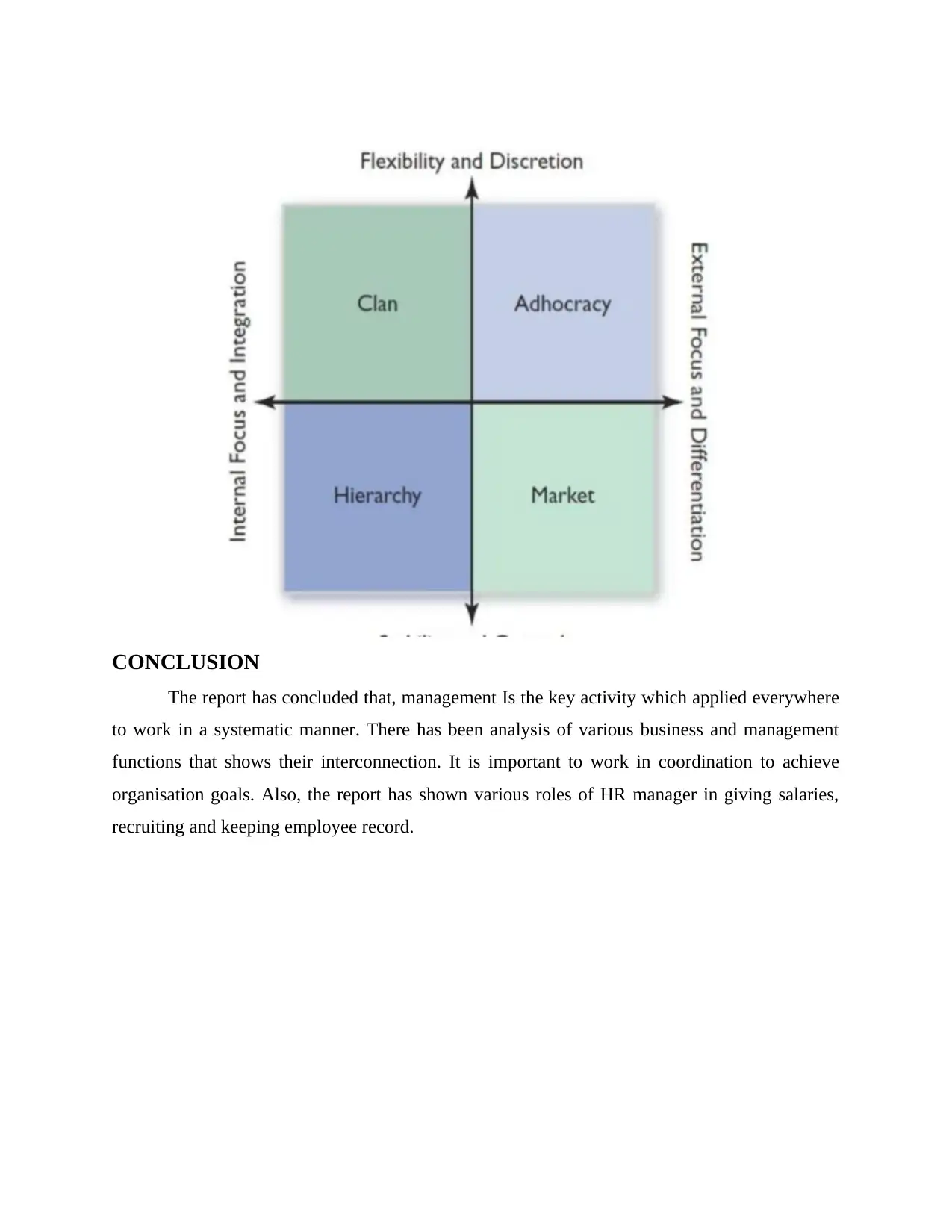
CONCLUSION
The report has concluded that, management Is the key activity which applied everywhere
to work in a systematic manner. There has been analysis of various business and management
functions that shows their interconnection. It is important to work in coordination to achieve
organisation goals. Also, the report has shown various roles of HR manager in giving salaries,
recruiting and keeping employee record.
The report has concluded that, management Is the key activity which applied everywhere
to work in a systematic manner. There has been analysis of various business and management
functions that shows their interconnection. It is important to work in coordination to achieve
organisation goals. Also, the report has shown various roles of HR manager in giving salaries,
recruiting and keeping employee record.
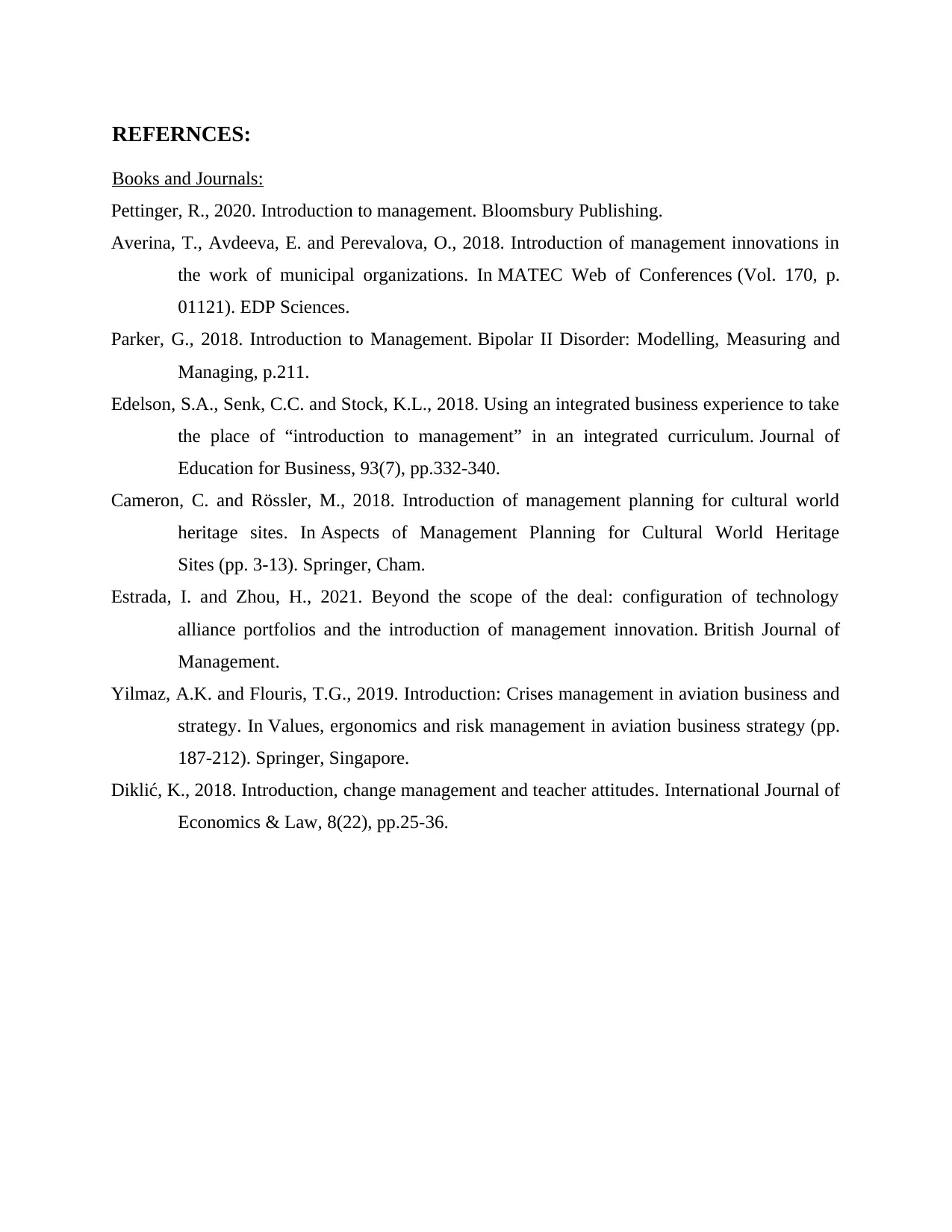
REFERNCES:
Books and Journals:
Pettinger, R., 2020. Introduction to management. Bloomsbury Publishing.
Averina, T., Avdeeva, E. and Perevalova, O., 2018. Introduction of management innovations in
the work of municipal organizations. In MATEC Web of Conferences (Vol. 170, p.
01121). EDP Sciences.
Parker, G., 2018. Introduction to Management. Bipolar II Disorder: Modelling, Measuring and
Managing, p.211.
Edelson, S.A., Senk, C.C. and Stock, K.L., 2018. Using an integrated business experience to take
the place of “introduction to management” in an integrated curriculum. Journal of
Education for Business, 93(7), pp.332-340.
Cameron, C. and Rössler, M., 2018. Introduction of management planning for cultural world
heritage sites. In Aspects of Management Planning for Cultural World Heritage
Sites (pp. 3-13). Springer, Cham.
Estrada, I. and Zhou, H., 2021. Beyond the scope of the deal: configuration of technology
alliance portfolios and the introduction of management innovation. British Journal of
Management.
Yilmaz, A.K. and Flouris, T.G., 2019. Introduction: Crises management in aviation business and
strategy. In Values, ergonomics and risk management in aviation business strategy (pp.
187-212). Springer, Singapore.
Diklić, K., 2018. Introduction, change management and teacher attitudes. International Journal of
Economics & Law, 8(22), pp.25-36.
Books and Journals:
Pettinger, R., 2020. Introduction to management. Bloomsbury Publishing.
Averina, T., Avdeeva, E. and Perevalova, O., 2018. Introduction of management innovations in
the work of municipal organizations. In MATEC Web of Conferences (Vol. 170, p.
01121). EDP Sciences.
Parker, G., 2018. Introduction to Management. Bipolar II Disorder: Modelling, Measuring and
Managing, p.211.
Edelson, S.A., Senk, C.C. and Stock, K.L., 2018. Using an integrated business experience to take
the place of “introduction to management” in an integrated curriculum. Journal of
Education for Business, 93(7), pp.332-340.
Cameron, C. and Rössler, M., 2018. Introduction of management planning for cultural world
heritage sites. In Aspects of Management Planning for Cultural World Heritage
Sites (pp. 3-13). Springer, Cham.
Estrada, I. and Zhou, H., 2021. Beyond the scope of the deal: configuration of technology
alliance portfolios and the introduction of management innovation. British Journal of
Management.
Yilmaz, A.K. and Flouris, T.G., 2019. Introduction: Crises management in aviation business and
strategy. In Values, ergonomics and risk management in aviation business strategy (pp.
187-212). Springer, Singapore.
Diklić, K., 2018. Introduction, change management and teacher attitudes. International Journal of
Economics & Law, 8(22), pp.25-36.
⊘ This is a preview!⊘
Do you want full access?
Subscribe today to unlock all pages.

Trusted by 1+ million students worldwide
1 out of 9
Related Documents
Your All-in-One AI-Powered Toolkit for Academic Success.
+13062052269
info@desklib.com
Available 24*7 on WhatsApp / Email
![[object Object]](/_next/static/media/star-bottom.7253800d.svg)
Unlock your academic potential
Copyright © 2020–2025 A2Z Services. All Rights Reserved. Developed and managed by ZUCOL.




